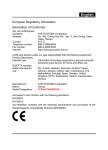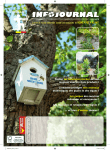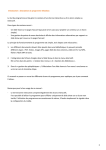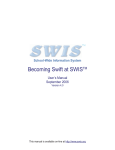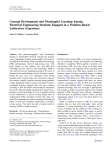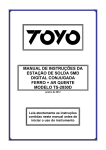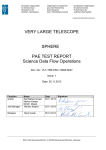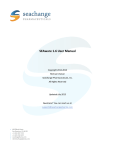Download DOCK 5
Transcript
DOCK 5.4 User Manual Irwin D. Kuntz Demetri T. Moustakas P. Therese Lang © University of California 2006 Last updated March 2006 General Overview Ligand File I/O Currently, only MOL2 file I/O is supported. Ligands are read in from a single MOL2 or multi-MOL2 file. Atom and bond types are assigned using the DOCK 4 atom/bond typing parameter files (vdw.defn, flex.defn, flex_table.defn). More information about all of these files can be found in the Appendix. There are several ligand output options, which write molecules to files whose names are formed using the output_file_prefix parameter: DOCK will always write out a scored molecules output file, which contains the best scoring pose for each molecule in the database. This will create a file called outputprefix_scored.mol2. Beyond this option, there are several other levels of sampling output: 1) Users can choose to write out orientations. This will create a file called outputprefix_orients.mol2. This will write out the molecules after they have been rigidly oriented and optimized. If anchor & grow is being used, this option will write out only the anchor fragment. All orientations generated will be written out, so be careful that the output does not get too huge. 2) Users can also write out conformers prior to final optimization. This will create a file called outputprefix_confs.mol2. Again, be aware that the number of molecules in the output file will be equal to the database size * the # of anchors per molecule * the number of orientations per anchor * the number of conformers per cycle. This file can grow quite large, so only use it on single poses or small databases. 3) Finally, users can write molecules ranked by score. This will create a file called outputprefix_ranked.mol2, which writes out the top N molecules from the database. This option disables the scored molecule output file by default, though users can override this and write out the best pose for each molecule as well. Rigid Orienting DOCK 5 uses receptor spheres and ligand heavy atom centers to rigidly orient ligands in the receptor. The spheres are generated using the accessory SPHGEN. Cliques of receptor spheres & ligand centers are identified using the maximum subgraph clique detection algorithm from DOCK 4. All cliques that satisfy the matching parameters are generated in the matching step, and can be sorted or ordered prior to the loop where the program cycles through the orientations. Both automated and manual matching are available in DOCK5. The sphere/center matches are determined by 2 parameters: 1) The distance tolerance is the tolerance in angstroms within which a pair of spheres is considered equivalent to a pair of centers 2) The distance minimum is the shortest distance allowed between 2 spheres (any sphere pair with a shorter distance is disregarded) Manual matching will create as many matches as possible given the specified parameters, and sort the matches according to the RMS error between the spheres and centers in the match. The matches are provided as orientations until either the max_orients # of orientations are reached, or the end of the match list is reached. Automated matching will start with the default values for the distance tolerance and distance minimum. A list of matches will be generated, and if the # of matches is less than the # max_orientations, then the distance tolerance is increased and the matching is repeated until there are at least max_orientations in the match list. Then the list is sorted, and orientations are generated. Ligand Flexibility Ligand flexibility in DOCK 5 uses the anchor-and-grow algorithm, which was introduced in DOCK 4. Rotatable bonds (not contained in rings) are used to partition the molecule into rigid segments, from which all anchors that meet the criteria are selected beginning with the largest anchor segment. All anchor orientations (or the starting orientation only, if no orienting is selected) are used as starting configurations onto which the first flexible layer is appended and conformationally expanded. The total population of conformers is then reduced to the number specified by num_confs_per_cycle, and the process is repeated until the last layer is reached. The conformer generator class now integrates score optimization in the anchor & grow algorithm. The anchors can be rigidly optimized, the final conformations can be rigidly, torsionally, or completely optimized, and the partially grown conformers can be completely optimized. The anchor & grow steps use whichever scoring function the user selects as the primary scoring function. The final minimization step uses the secondary scoring function. Scoring Functions This release of DOCK5 implements a hierarchical scoring function strategy. A master score class manages all scoring functions that DOCK uses. Any of the DOCK scoring functions can be selected as the primary and/or the secondary scoring function. The primary scoring function is used during the rigid minimization, and anchor & grow steps, which typically make many calls to the scoring function. The secondary scoring function is used in the final minimization, scoring, and ranking of the molecules. If no secondary scoring function is selected, the primary scoring function is used as the secondary. This release contains continuous molecular mechanics based scoring (vdw + columbic terms only), grid-based molecular mechanics scoring, contact scoring and bump filtering as implemented in DOCK 4. Scoring grids are created using the GRID program. DOCK also contains GB/SA scoring, as implemented in SDOCK. Scoring grids for the GBSA code are calculated using the accessories nchemgrid_GB and nchemgrid_SA. This release also includes an internal energy scoring function, which is used during the anchor & grow flexible search. This function computes the Lennard-Jones and columbic energy between all ligand atom pairs, excluding all 1-2, 1-3, and 1-4 pairs. This energy is not included in the final reported score. Score Optimization Score optimization is implemented using a simplex minimizer based on the DOCK 4 minimizer. Users can choose to minimize the rigid anchors, minimize during flexible growth, and minimize the final conformation. The anchor minimization is always done rigidly; also, if no flexible growth is being done, this step will minimize the entire molecule. The minimization during the flexible growth is a complete (torsions + rigid) minimization. The final minimization can be rigid or torsions only, or complete. When the simplex “shrinks” enough so that the highest and lowest points are within the scoring tolerance or if the number of requested minimizer steps is reached, the minimizer terminates. Using DOCK Installing DOCK 1. Save file for appropriate operating system to hard drive. 2. Uncompress the archive into a folder called dock5/ in a directory of your choice. a. For windows systems, a Zip file is provided b. For *nix systems, a gzipped archive is provided 3. All DOCK 5 binaries are installed in dock5/bin/ The dock5 directory contains the following subdirectories: bin/ demo/ installation/ parameters/ src/ utilities/ accessories/ grid/ GBSA_Grids/ Compiling DOCK (if required) DOCK comes with platform specific compiled binaries. You should not need to compile the code or accessories unless you have made changes to the source code, or are planning to run DOCK on a platform for which we do not distribute binaries. Building DOCK: (all platforms) From the dock5 directory: cd config/ ./configure gnu make DOCK with mpi function is built upon an mpi library. The MPICH library is provided freely by Argonne National Labs (http://wwwunix.mcs.anl.gov/mpi/mpich/). The MPI library needs to be installed and running on the system if the MPI features are to be used. Once MPI is installed, you need to define MPICH_HOME as an environment variable. Building MPI-DOCK (all platforms): From the dock5 directory: cd config/ ./configure gnu.parallel make NOTE: MPI-DOCK 5.4 has been compiled with MPICH-1.2.7 on all supported platforms (MPICH-1.2.5 for WinXP). Running DOCK For Windows Users: DOCK and its accessories must be run using a Linux-like environment like Cygwin (http://www.cygwin.com/). When you install your emulator, make sure to also install compilers and unix shells (“Devel” for Cygwin). DOCK must be run command line from a standard unix shell. It reads a parameter file containing field/value pairs using the following command: dock5/bin/dock5 -i parameter.in [-v1] [-v2] [-o outputfile.txt] If the parameter file does not exist, DOCK will generate one using your responses to the parameter questions. If the parameter file exists, any parameter values found will be read. DOCK 5 outputs the job parameters to the screen at the start of the job, and prints summary information for each molecule processed. Additional summary information will be included in future releases. The –v1 flag prints a histogram of sphere matching information. The –v2 flag prints details about the breakdown of the GB/SA terms. Running DOCK in Parallel If you have installed the MPI library, DOCK can be run in parallel using the following command: mpirun –np # dock5.mpi -i parameter.in –o outputfile.txt Note that that parallezation is set up to have a single Master node with the remaining nodes act as slaves. The Master node performs file processing and input/output, whereas the slaves perform the actual calculations. If –np = 1, the code defaults to non-MPI behavior. As a result, there will be minimal difference in performance between 1 and 2 processors. Improved performance will only become evident with more than 2 nodes. Running the Demo DOCK 5.4 includes two demonstration files that are designed to test your installation. These demos must also be run command-line. For DOCK: (all platforms) From the dock5 directory: cd demo ./script_clean ./script_demo For MPI-DOCK: (all platforms) From the dock5 directory: cd demo ./script_clean ./script_mpi_demo NOTE: MPI-DOCK will be run on 4 processors for the demo DOCK 5 Parameters The parameters for several common calculations have been optimized using test sets. General recommendations for these parameters can be found in dock5/recommended_input. Below, all available options for DOCK are described in detail. The DOCK 5 parameter parser requires that the values entered for a parameter exactly match one of the legal values if any legal values are specified. For example: param_a param_b [5] (): [5] (0 5 10): param_a can be assigned any value, however param_b can only be assigned 0, 5, or 10. If no value is entered, both will default to a value of 5. Below are listed all DOCK 5 parameters, their default values, legal values, and a brief description of each. The parameters are listed in order of function. Also, for questions requiring a yes/no answer, please use the full word (yes or no) as opposed to y or n. Parameter Name Ligand I/O Parameters Default Values Description ligand_atom_file database.mol2 string ligand_outfile_prefix output string limit_max_ligands no write_orientations no write_conformations no yes, no initial_skip 0 int calculate_rmsd no yes, no use_rmsd_reference_mol no yes, no rmsd_reference_filename ligand_rmsd.mol2 string rank_ligands no yes, no bool (yes, no) bool (yes, no) The ligand input filename The prefix that all output files will use The maximum # of ligands that will be read in from a library Flag to write orientations Flag to write conformations The # of molecules to skip over at the beginning of a library Flag to perform an RMSD calculation between the final molecule pose and its initial structure. Specify reference structure for RMSD calculation (default is starting structure) File containing RMSD reference structure Flag to enable a ligand topscore list. These ligands will be written to outfile_ranked.mol2, and outfile_scored.mol2 will be max_ranked_ligands 500 int scored_conformer_output_override no yes, no num_scored_conformers_written 1 int cluster_conformations yes yes, no cluster_rmsd_threshold 2.0 float empty by default The # of ligands to be stored in the top score list This flag causes all ligands to be written to outfile_scored.mol2, even when rank_ligands is true The # of scored poses for each ligand printed to output_scored.mol2 Flag to enable clustering of fully minimized conformations (NOTE: Only available if num_scored_confomers_written > 1) The cutoff to determine whether conformations should be clustered Parameter Name Orient Ligand Parameters Default Values Description orient_ligand yes bool (yes, no) automated_matching yes bool (yes, no) distance_tolerence 0.25 float distance_minimum 2.0 float nodes_minimum 3 int nodes_maximum 10 int receptor_site_file receptor.sph string max_orientations 500 int critical_points no bool (yes, no) chemical_matching no bool (yes, no) chem_match_tbl chem_match.tbl string use_ligand_spheres no bool (yes, no) ligand_sphere_file ligand.sph string Flexible Ligand Parameters Flag to orient ligand to spheres Flag to perform automated matching instead of manual matching The distance tolerance applied to each edge in a clique The minimum size for an edge in a clique The minimum # of nodes in a clique The maximum # of nodes in a clique The file containing the receptor spheres The maximum # of orientations that will be cycled through Flag to use critical point sphere labeling to target orientations to particular spheres Flag to use chemical “coloring” of spheres to match chemical labels on ligand atoms File defining the legal chemical type matches/pairings Flag to enable a sphere file representing ligand heavy atoms to be used to orient the ligand. Typically used for macromolecular docking Ligand spheres Parameter Name Default Values flexible_ligand yes bool (yes, no) ag_conf_search yes bool (yes, no) min_anchor_size 40 int num_anchor_orients_for_growth 100 int number_confs_for_next_growth 100 int use_internal_energy yes bool (yes, no) internal_energy_att_exp 6 int internal_energy_rep_exp 12 int internal_energy_dielectric 4.0 float use_clash_overlap no bool (yes, no) clash_overlap 0.5 float Parameter Name Description Flag to perform ligand conformational searching Flag to use the anchor & grow algorithm to search ligand conformations The minimum # of heavy atoms for an anchor segment The maximum number of anchor orientations promoted to the conformational search The maximum number of conformations carried forward in the anchor & grow search Flag to add an internal energy term to the score during the conformational search VDW attractive exponent VDW repulsive exponent Dielectric used for electrostatic calculation Flag to check for overlapping atom volumes during anchor and grow Percent of overlap allowed before a clash is declared Ligand Scoring Parameters Default Values Description bump_filter yes bool (yes, no) bump_grid_prefix grid string max_bumps 2 int score_molecules yes bool (yes, no) contact_score_primary no bool (yes, no) contact_score_secondary no bool (yes, no) contact_score_cutoff_distance 4.5 float contact_score_clash_overlap 0.75 float contact_score_clash_penalty 50 int contact_score_grid_prefix grid string Flag to perform bump filtering The prefix to the grid file(s) containing the desired bump grid The maximum allowed # of bumps for a molecule to pass the filter Enables scoring of molecules Flag to perform contact scoring as the primary scoring function Flag to perform contact scoring as the secondary scoring function The distance threshold defining a contact Contact definition for use with intramolecular scoring The penalty for each contact overlap made The prefix to the grid files receptor.mol2 string 6 int 12 int 4.0 float containing the desired cnt grid Flag to perform grid-based energy scoring as the primary scoring function Flag to perform grid-based energy scoring as the secondary scoring function Scalar multiplier of the vdw energy component Scalar multiplier of the electrostatic energy component The prefix to the grid files containing the desired nrg grid Flag to perform continuous non-grid based scoring Flag to perform continuous non-grid based scoring File that contains receptor coordinates VDW L-J potential attractive exponent VDW L-J potential repulsive exponent Dielectric constant for electrostatic term 1 float Scalar multiplier of vdw energy component grid_score_primary yes bool (yes, no) grid_score_secondary yes bool (yes, no) grid_score_vdw_scale 1 float grid_score_es_scale 1 float grid_score_grid_prefix grid string continuous_score_primary no continuous_score_secondary no cont_score_rec_filename cont_score_att_exp cont_score_rep_exp cont_score_dielectric cont_score_vdw_scale cont_score_es_scale bool (yes, no) bool (yes, no) 1 float gbsa_pairwise_score_primary no bool (yes, no) gbsa_pairwise_score_secondary no bool (yes, no) gbsa_pairwise_gb_grid_prefix gb_grid string gbsa_pairwise_sa_grid_prefix sa_grid string gbsa_pairwise_vdw_grid_prefix grid string gbsa_pairwise_screen_file screen.in string gbsa_pairwise_solvent_dielectric 78.300003 float Scalar multiplier of electrostatic energy component Toggles whether or not to use GB/SA scoring as the primary scoring function Toggles whether or not to use GB/SA scoring as the secondary scoring function The path to the pairwise GB grids The path to the SA grids The path to the dock4 nrg grids, used for the vdw portion of the GB/SA calculation GB parameter file for electrostatic screening. Its located in the parameters dir by default The value for the solvent dielectric Score Optimization Parameters Default Values Description Parameter Name minimize_ligand yes bool (yes, no) minimize_anchor yes bool (yes, no) minimize_flexible_growth yes bool (yes, no) minimize_final_pose yes bool (yes, no) use_advanced_simplex_parameters no bool (yes, no) Parameter Name Flag to perform score optimization Flag to perform rigid optimization of the anchor Flag to perform complete optimization during conformational search Flag to perform minimization of the final ligand pose Flag to use a simplified set of common minimization parameters for each of the minimization steps listed above Basic Simplex Minimizer Parameters Default Values Description simplex_max_cycles simplex_score_converge simplex_cycle_converge simplex_trans_step simplex_rot_step simplex_tors_step simplex_anchor_max_iterations simplex_grow_max_iterations simplex_final_max_iterations simplex_random_seed 1 int 0.1 float 1.0 float 1.0 float 0.1 float 10.0 float 500 int 500 int 0 int 0 int Maximum # of minimization cycles Exit cycle at when energy converges at cutoff Exit minimization when cycles converge at cutoff Initial translation step size Initial rotation step size Initial torsion angle step size Maximum # of iterations per cycle per anchor Maximum # of iterations per cycle per growth step Maximum # of iterations per cycle for entire molecule using secondary scoring function Seed for random number generator Advanced Simplex Minimizer Parameters Parameter Name Default Values Description simplex_anchor_max_iterations simplex_anchor_max_cycles simplex_anchor_score_converge simplex_anchor_cycle_converge 50 int 1 int 0.1 float 1.0 float Maximum # of minimization cycles Maximum # of minimization cycles Exit cycle at when energy converges at cutoff Exit minimization when cycles simplex_anchor_trans_step simplex_anchor_rot_step simplex_anchor_tors_step 1.0 float 0.1 float 10.0 float converge at cutoff Initial translation step size Initial rotation step size Initial torsion angle step size NOTE: Repeat for minimization of each layer (simplex_grow_xxx) and final minimization (simplex_final_xxx) Parameter Name Atom & Bond Typing Parameters Default Legal Description atom_model all string (all, united) vdw_defn_file vdw.defn string flex_defn_file flex.defn string flex_drive_file flex_drive.tbl string chem._defn_file chem.defn string Choice of all atom or united atom models File containing vdw parameters for atom types File containing bond definition parameters File containing conformational search parameters File containing chemical label (pharmacophore) definitions ACCESSORIES GRID Author: Todd Ewing Based on work by Elaine Meng and Brian Shoichet Overview GRID creates the grid files necessary for rapid score evaluation in DOCK. Two types of scoring are available: contact and energy scoring. The scoring grids are stored in files ending in *.cnt and *.nrg respectively. When docking, each scoring function is applied independent of the others and the results are written to separate output files. GRID also computes a bump grid which identifies whether a ligand atom is in severe steric overlap with a receptor atom. The bump grid is identified with a *.bmp file extension. The file containing the bump grid also stores the size, position and grid spacing of all the grids. The grid calculation must be performed prior to docking. The calculation can take up to 45 minutes, but needs to be done only once for each receptor site. Since DOCK can perform continuum scoring without a grid, the grid calculation is not always required. However, for most docking tasks, such as when multiple binding modes for a molecule or multiple molecules are considered, it will become more time efficient to precompute the scoring grids. Bump Checking Prior to scoring, each orientation can be processed with the bump filter to reject ones that penetrate deep into the receptor. Orientations that pass the bump filter are then scored and/or minimized with any of the available scoring functions. A bump is based on the sum of the van der Waals radii of the two interacting atoms. The user specifies what fraction of the sum is considered a bump. For example, the default definition of a bump is if any two atoms approach closer than 0.75 of the sum of their radii. GRID stores an atomic radius which corresponds to smallest radius of ligand atom at the grid position which would still trigger a bump. During docking, for a given orientation, the position of each atom is checked with the bump grid. If the radius of the atom is greater than or equal to the radius stored in the bump grid, then the atom triggers a bump. To conserve disk space, the atom radius is multiplied by 10 and converted to a short unsigned integer. Energy scoring The energy scoring component of DOCK is based on the implementation of force field scoring. Force field scores are approximate molecular mechanics interaction energies, consisting of van der Waals and electrostatic components: 75 where each term is a double sum over ligand atoms i and receptor atoms j, which include the quantities listed below. Generalization of the VDW component The van der Waals component of the scoring function has been generalized to handle any combination of repulsive and attractive exponents (providing that a> b). The user may choose to "soften" the potential by using a 69 Lennard-Jones function. The general form of the van der Waals interaction between two identical atoms is presented: where ε is the well depth of the interaction energy, R is the van der Waals radius of the atoms, and coefficients C and D can be determined given the two following boundary conditions: at at Application of these boundary conditions to the above equation yields an expression of the van der Waals interaction with a generalized Lennard-Jones potential. The consequence of using a different exponent for the repulsive term is illustrated in Figure 1. Notice that the well position and depth are unchanged, but that the repulsive barrier has shrunk by about a 0.25 Angstrom. Figure 1: Distance dependence of the Lennard-Jones Function Precomputing potentials on a grid By inspection of the above equations, the repulsion and attraction parameters (Aij and Bij) for the interactions of identical atoms can be derived from the van der Waals radius, R, and the well depth, ε. In order to evaluate the interaction energy quickly, the van der Waals and electrostatic potentials are precomputed for the receptor and stored on a grid of points containing the docking site. Precomputing the van der Waals potential requires the use of a geometric mean approximation for the A and B terms, as shown: Using this approximation, the first equation can be rewritten: Three values are stored for every grid point k,each a sum over receptor atoms that are within a user defined cutoff distance of the point: These values, with trilinear interpolation, are multiplied by the appropriate ligand values to give the interaction energy. GRID calculates the grid values and stores them in files. The values are read in during a DOCK run and used for force field scoring. The user determines the location and dimensions of the grid box using the program SHOWBOX. It is not necessary for the whole receptor to be enclosed; only the regions where ligand atoms may be placed need to be included. The box merely delimits the space where grid points are located, and does not cause receptor atoms to be excluded from the calculation. Besides a direct specification of coordinates, there is an option to center the grid at a sphere cluster center of mass. Any combination of spacing and x, y, and z extents may be used. Contact Scoring Contact scoring in GRID incorporates the scoring performed with the DISTMAP program developed by Shoichet and Bodian. The score is a summation of the heavy atom contacts (every atom except hydrogen) between the ligand and receptor. A contact is defined as an approach of two atoms within some cutoff distance (usually 4.5 Angstroms). If the two atoms approach close enough to bump (as identified with the bump grid) then the interaction can be penalized by an amount specified by the user. The distance dependence of the contact score is represented in Figure 2. Figure 2. Distance dependence of contact score function The attractive score in GRID is negative and a repulsive score is positive. This switch of sign is necessary to allow the same minimization protocol to be used for contact scoring as implemented for energy scoring. Running GRID GRID must be run command line from a standard unix shell. It reads a parameter file containing field/value pairs using the following command: grid -i grid.in [-stv] [-o grid.out] -i input_file (Input parameters extracted from input_file, or grid.in if not specified) -o output_file (Output written to output_file, or grid.out if not specified) -s Input parameters entered interactively -t Reduced output level -v Increased output level Parameter Name General Parameters Default Value compute_grids grid_spacing no 0.3 bool (yes, no) float Flag to compute scoring grids The distance between grid points along each axis. output_molecule no bool (yes, no) Flag to write out the coordinates of the receptor into a new, cleaned-up file. Atoms are resorted to put all residue atoms together. Terminal SYBYL capping groups are Description merged with the terminal residues. Parameter Name Scoring Parameters Default Value Description contact_score contact_cutoff_distance no 4.5 bool (yes, no) float chemical_score energy_score energy_cutoff_distance no no 10 bool (yes, no) bool (yes, no) float atom_model u string (u, a) attractive_exponent 6 int repulsive_exponent 12 int distance_dielectric yes bool (yes, no) dielectric_factor bump_filter 4.0 no float bool (yes, no) bump_overlap 0.75 float Flag to construct contact grid Maximum distance between heavy atoms for the interaction to be counted as a contact Flag to construct chemical grid Flag to perform energy scoring Maximum distance between two atoms for their contribution to the energy score to be computed Flag for how to model of nonpolar hydrogens u = United atom model. Hydrogens attached to carbons are assigned a zero VDW well-depth and the partial charge is transferred to the carbon. a = All atom model. Hydrogens attached to carbons have regular VDW well-depth and partial charge is not modified. Exponent of attractive LennardJones term for VDW potential Exponent of repulsive LennardJones term for VDW potential Flag to make the dielectric depend linearly on the distance Coefficient of the dielectric Flag to screen each orientation for clashes with receptor prior to scoring and minimizing Amount of VDW overlap allowed. If the probe atom and the receptor heavy atom approach closer than this fraction of the sum of their VDW radii, then the position is flagged as a bump. 0 = Complete overlap allowed. 1 = No overlap allowed File Input Value Parameter Name Default receptor_file receptor.mol2 bool (yes, no) Description Receptor coordinate file. box_file site_box.pdb float vdw_definition_file vdw.defn string Partial charges and atom types need to be present. File containing SHOWBOX output file which specifies boundaries of grid VDW parameter file. File Output Value Parameter Name Default score_grid_prefix grid string receptor_out_file receptor_out.mol2 string Description Core file name of grids (file extension will be appended automatically) File for cleaned-up receptor when output_molecule set NCHEMGRID_GB and NCHEMGRID_SA Author: Xiaoqin Zou Overview The NCHEMGRID_GB and NCHEMGRID_SA programs create the GB and SA receptor grids for use with DOCK 5's GB/SA scoring function. Input Both programs require that an INCHEM file be created in the working directory, which contains the parameters to control the program. The INCHEM parameters for both the NCHEMGRID_GB and NCHEMGRID_SA programs are detailed below: For NCHEMGRID_GB: receptor.pdb cavity.pdb parameters/prot.table.ambcrg.ambH parameters/vdw.parms.amb box.pdb 0.4 2 1 8.0 8.0 78.3 78.3 solvent,cavity 2.3 2.8 output_prefix 1 ; receptor pdb file ; cavity pdb file ; charge parameter file ; VDW parameter file ; box pdb file ; grid spacing in angstroms ; es type: GB ; es scale for ff scoring ; cutoff for es and outer box ; dielectric of ; bumping distances ; output grid prefix name ; pairwise calculation NOTE: The cavity.pdb file should be an empty file. This feature is not frequently used. However, the parameter must still be passed. The pairwise calculation value must also always be 1. For NCHEMGRID_SA: receptor.pdb pararameters/prot.table.ambcrg.ambH parameters/vdw.parms.amb box.pdb 0.4 1.4 2 8.0 output_prefix ; receptor pdb file ; charge parameter file ; VDW parameter file ; box pdb file ; grid spacing in angstroms ; probe radius for SA ; scoring type: SA ; cutoff for SA calculations ; output grid prefix name SPHGEN Author: Irwin D. Kuntz Modified by: Renee DesJarlais, Brian Shoichet Overview SPHGEN generates sets of overlapping spheres to describe the shape of a molecule or molecular surface. For receptors, a negative image of the surface invaginations is created; for a ligand, the program creates a positive image of the entire molecule. Spheres are constructed using the molecular surface described by Richards (1977) calculated with the program dms (www.cgl.ucsf.edu). Each sphere touches the molecular surface at two points and has its radius along the surface normal of one of the points. For the receptor, each sphere center is “outside” the surface, and lies in the direction of a surface normal vector. For a ligand, each sphere center is “inside” the surface, and lies in the direction of a reversed surface normal vector. Spheres are calculated over the entire surface, producing approximately one sphere per surface point. This very dense representation is then filtered to keep only the largest sphere associated with each receptor surface atom. The filtered set is then clustered on the basis of radial overlap between the spheres using a single linkage algorithm. This creates a negative image of the receptor surface, where each invagination is characterized by a set of overlapping spheres. These sets, or “clusters,” are sorted according to numbers of constituent spheres, and written out in order of descending size. The largest cluster is typically the ligand binding site of the receptor molecule. The program showsphere writes out sphere center coordinates in PDB format and may be helpful for visualizing the clusters. Input rec.ms R X #molecular surface file #sphere outside of surface (R) or inside surface (L) #specifies subset of surface points to be used (X=all points) 0.0 4.0 1.4 #prevents generation of large spheres with close surface contacts (default=0.0) #maximum sphere radius in Angstroms (default=4.0) #minimum sphere radius in Angstroms (default=radius of probe) rec.sph #clustered spheres file NOTES: 1) The input file names and parameters are read from a file called INSPH, which should not contain any blank lines or the comments (denoted by #) from above. 2) The molecular surface file must include surface normals. SPHGEN expects the Fortran format (A3, I5, X, A4, X, 2F8.3, F9.3, X, A3, 7X, 3F7.3). Output Some informative messages are written to a file called OUTSPH. This includes the parameters and files used in the calculation. The spheres themselves are written to the clustered spheres file. They are arranged in clusters with the cluster having the largest number of spheres appearing first. The sphere cluster file consists of a header followed by a series of sphere clusters. The header is the line “DOCK 3.5 receptor_spheres” followed by a color table. The color table contains color names (format A30) each on a separate line. As SPHGEN produces no colors, the color table is simply absent. The sphere clusters themselves follow, each of which starts with the line cluster n number of spheres in cluster i where n is the cluster number for that sphere cluster, and i is the number of spheres in that cluster. Next, all spheres in that cluster are listed in the format (I5, 3F10.5, F8.3, I5, I2, I3) where the values correspond to, respectively, • The number of the atom with which surface point i (used to generate the sphere) is associated. • The x, y,and z coordinates of the sphere center. • The sphere radius. • The number of the atom with which surface point j (second point used to generate the sphere) is associated. • The critical cluster to which this sphere belongs. • The sphere color. The color is simply an index into the color table that was specified in the header. Therefore, 1 corresponds to the first color in the header, 2 for the second, etc. 0 corresponds to unlabeled. The clusters are listed in numerical order from largest cluster found to the smallest. At the end of the clusters is cluster number 0. This is not an actual sphere cluster, but a list of allof the spheres generated whose radii were larger than the minimum radius, before the filtering heuristics ( i.e. allowing only one sphere per atom and using a maximum radius cutoff) and clustering were performed. Cluster 0 may be useful as a starting point for users who want to explore a wider range of possible clusters than is provided by the standard SPHGEN clustering routine. The program creates three temporary files: temp1.ms, temp2.sph, and temp3.atc. These are used internally by SPHGEN, and are deleted upon completion of the computation. For more information on sphere generation and selection, go to the demo. SHOWBOX Author: Elaine Meng SHOWBOX is an interactive program that allows visualization of the location and size of the grids that will be calculated by the program grid, using any graphics program that can display PDB format. The user is asked whether the box should be automatically constructed to enclose all of the spheres in a cluster. If so, the user must also enter a value for how closely the box faces may approach a sphere center (how large a “cushion” of space is desired) and the sphere cluster filename and number. If not, the user is asked whether the box will be centered on manually entered coordinates or a sphere cluster center of mass. Depending on the response, the coordinates of the center or the sphere cluster filename and number are requested. Finally, the user must enter the desired box dimensions (if not automatic) and a name for the output PDB-format box file. SHOWSPHERE Authors: Stuart Oatley, Elaine Meng, Daniel Gschwend SHOWSPHERE is an interactive program; it produces a PDB-format file of sphere centers and an MS-like file of sphere surfaces, given the sphere cluster file and cluster number. The surface file generation is optional. The user may specify one cluster or “all,” and multiple output files will be generated, with the cluster number appended to the end of the name of each file. The input cluster file is created using SPHGEN. SHOWSPHERE requests the name of the sphere cluster file, the number of the cluster of interest, and names for the output files. Information is sent to the screen while the spheres are being read in, and while the surface points are being calculated. SPHERE_SELECTOR Author: P. Therese Lang SPHERE_SELECTOR will take the ouput from SPHGEN and select all spheres with a user-defined radius of a target molecule. The target molecule can be anything (ie known ligand, receptor residue, ect) as long as it is in proper MOL2 format. The required input for sphere_selector is: USAGE: sphere_selector <sphere_cluster_file.sph> <set_of_atoms.mol2> <radius> Please note that above order of input files must be maintained for the program to work. APPENDIX 1: Parameter File Formats Overview The parameter files contain atom and bond data needed during DOCK calculations. The definition (*.defn) files contain atom and bond labeling data. The table (*.tbl) files contain additional data for chemical interactions and flexible bond torsion positions. They may be edited by the user. Atom Definition Rules The definition files use a consistent atom labeling convention for which an atom in virtually any chemical environment can be identified. The specification of adjacent atoms is nested using the elements listed below. • • • Each element must be separated by a space. If more than one adjacent atom is specified, then ALL must be present (i.e. a boolean AND for rules within a line). If a label can have multiple definition lines, then any ONE of them must be satisfied for inclusion (i.e. a boolean OR for rules on different lines). Element atom type ( ) [ ] integer Example C.2 ( 2 O.co2 ) .3 [ 3 H ] Atom Definition Elements Function Specifies partial or complete atom type. A partial specification is more general (i.e. "C" versus "C.3"). An asterisk (*) specifies ANY atom type. Specifies atoms that must be bonded to parent atom. Specifies atoms that must NOT be bonded to parent atom. Specifies the number of an atom that must be bonded. Example Definitions Explanation A carboxylate carbon. Any sp3 hybridized atom that is not attached to three hydrogens. C. [ O. ] [ N. [ 2 O.2 ] [ 2 C. ] ] Any carbon not attached to an oxygen or a nitrogen (unless the nitrogen is a nitro or tertiary nitrogen). vdw.defn This file contains atom labels and definitions for van der Waals atom typing. • The following data types are associated with each atom: VDW radius, VDW well-depth, flag for heavy atom, number of attached atoms. • Some labels are used only for the united-atom model, some for only the all-atom model, and some for either. • A label may have multiple definitions. Sample Entries from vdw.defn _____________________________________ name Carbon_sp/sp2 atom_model either radius 1.850 well_depth 0.120 heavy_flag 1 valence 4 definition C _____________________________________ name Carbon_All_sp3 atom_model all radius 1.800 well_depth 0.060 heavy_flag 1 valence 4 definition C.3 _____________________________________ name Carbon_United_CH3 atom_model united radius 2.000 well_depth 0.150 heavy_flag 1 valence 4 definition C. ( 3 H ) _____________________________________e chem.defn This file contains labels and definitions for chemical labeling. • Nothing in addition to a label is assigned to an atom. • A label may have multiple definition lines. Sample Entries from chem.defn ______________________________________________________ __ name hydrophobic definition C. [ O. ] [ N. [ 2 O.2 ] [ 2 C. ] ] ( * ) definition N.pl3 ( 3 C. ) definition Cl ( C. ) definition Br ( C. ) definition I ( C. ) definition C.3 [ * ] ________________________________________________________ name donor definition N. ( H ) definition N.4 [ * ] ________________________________________________________ name acceptor definition O. [ H ] [ N. ] ( * ) definition O.3 ( 1 * ) [ N. ] definition O.co2 ( C.2 ( O.co2 ) ) definition N. [ H ] [ N. ] [ O. ] [ 3 . ] ( * ) definition O.2 [ * ] ________________________________________________________ chem_match.tbl This file contains the interaction matrix for which chemical labels can form an interaction in matching. • The labels must be identical to labels in chem.defn. • The table flag indicates the beginning of the interaction table. • Compatible labels are identified with a one, otherwise a zero. Sample of chem_match.tbl label null label hydrophobic label donor label acceptor label polar table 1 1 1 1 0 1 1 0 0 1 1 0 1 1 nual Parameter Files 1 flex.defn This file contains labels and definitions for flexible bond identification. • The drive_id field corresponds to a torsion type in the flex_drive.tbl file. • The minimize field is a flag for whether the bond may be minimized. • Two definition lines must be present. Each definition corresponds to an atom at either end of the bond. Sample Entries from flex.defn ________________________________________ name sp3-sp3 drive_id 3 minimize 1 definition .3 [ 3 H ] [ 3 O.co2 ] definition .3 [ 3 H ] [ 3 O.co2 ] ________________________________________ name sp3-sp2 drive_id 4 minimize 1 definition .3 [ 3 H ] [ 3 O.co2 ] definition .2 [ 2 H ] [ 2 O.co2 ] ________________________________________ name sp2-sp2 drive_id 2 minimize 0 definition .2 [ 2 H ] [ 2 O.co2 ] definition .2 [ 2 H ] [ 2 O.co2 ] ________________________________________ flex_drive.tbl This file contains torsion positions assigned to each rotatable bond when the flexible docking parameter is used in DOCK. • The drive_id field corresponds to each torsion type. • The positions field specifies the number of torsion angles to sample. • The torsions field specifies the angles that are sampled. Sample Entries from flex_drive.defn _________________________________________ drive_id 2 positions 2 torsions 0 180 _________________________________________ drive_id 3 positions 3 torsions -60 60 180 _________________________________________ drive_id 4 positions 4 torsions -90 0 90 180 _________________________________________ APPENDIX 2: Molecular File Formats Tripos MOL2 format Overview This format is used for general molecule input and output of DOCK. This format has the advantage of storing all the necessary information for atom features, position, and connectivity. It is also a standardized format that other modeling programs can read. Specification Of the many record types in a MOL2 file, DOCK recognizes the following: MOLECULE, ATOM, BOND, SUBSTRUCTURE and SET. In the MOLECULE record, DOCK utilizes information about the molecule name and number of atoms, bonds, substructures and sets. In the ATOM record DOCK utilizes information about the atom names, types, coordinates, and partial charges. In the BOND record, DOCK utilizes the atom identifiers for the bond. In the SUBSTRUCTURE record, DOCK records the fields, but does not utilize them. The SET records are entirely optional. They are used only in special circumstances, like when the use wants to define the anchor for flexible docking. Please refer to Sybyl documentation for additional information. Example This example file illustrates all the elements of the MOL2 file read and written by dock. It includes optional SET records which are used by the ligand flexibility routines. @<TRIPOS>MOLECULE example 23 23 1 GAST_HUCK @<TRIPOS>ATOM 1 C 0.0529 2 H 0.0571 3 C 0.0242 4 C 0.0319 5 H 0.0598 6 H 0.0598 7 N 0.3075 8 H 0.1243 9 C 0.0136 10 H 0.0390 11 H 0.0390 12 H 0.0390 13 C 0.0529 14 H 0.0571 0 2 1.2300 0.7100 0.0000 C.ar 1 ABC 2.1620 1.2490 0.0000 H 1 ABC 0.0000 1.4200 0.0000 C.ar 1 ABC 0.0000 2.9060 0.0000 C.3 1 ABC -0.5150 3.2700 0.8920 H 1 ABC -0.5150 3.2700 -0.8920 H 1 ABC 1.3680 3.3900 0.0000 N.3 1 ABC 1.8480 3.0500 0.8320 H 1 ABC 1.3680 4.8410 0.0000 C.3 1 ABC 0.8530 5.2050 0.8920 H 1 ABC 0.8530 5.2050 -0.8920 H 1 ABC 2.3990 5.2050 0.0000 H 1 ABC -1.2300 0.7100 0.0000 C.ar 1 ABC -2.1620 1.2490 0.0000 H 1 ABC - - - - - 15 C -1.2300 -0.7100 0.0000 C.ar 1 ABC 0.0471 16 H -2.1620 -1.2490 0.0000 H 1 ABC 0.0655 17 C -0.0000 -1.4200 0.0000 C.ar 1 ABC 0.0547 18 C 1.2300 -0.7100 0.0000 C.ar 1 ABC 0.0471 19 H 2.1620 -1.2490 0.0000 H 1 ABC 0.0655 20 C -0.0000 -2.7800 0.0000 C.2 1 ABC 0.2555 21 O -0.0850 -3.5030 0.9750 O.2 1 ABC 0.3604 22 O 0.1090 -3.2660 -1.2480 O.3 1 ABC 0.2944 23 H 0.1010 -4.2400 -1.1490 H 1 ABC 0.2522 @<TRIPOS>BOND 1 1 2 1 2 1 18 ar 3 1 3 ar 4 3 13 ar 5 3 4 1 6 4 6 1 7 4 5 1 8 4 7 1 9 7 8 1 10 7 9 1 11 9 12 1 12 9 11 1 13 9 10 1 14 13 14 1 15 13 15 ar 16 15 16 1 17 15 17 ar 18 17 20 1 19 17 18 ar 20 18 19 1 21 20 21 2 22 20 22 1 23 22 23 1 @<TRIPOS>SUBSTRUCTURE 1 ABC 1 GROUP 0 A **** 0 ROOT @<TRIPOS>SET ANCHOR STATIC ATOMS <user> **** Anchor atom set 6 1 3 13 15 17 18 RIGID STATIC BONDS <user> **** Rigid bond set 6 2 3 4 15 17 19 - - -






























